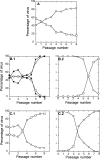Deterministic, compensatory mutational events in the capsid of foot-and-mouth disease virus in response to the introduction of mutations found in viruses from persistent infections
- PMID: 17151123
- PMCID: PMC1797555
- DOI: 10.1128/JVI.01899-06
Deterministic, compensatory mutational events in the capsid of foot-and-mouth disease virus in response to the introduction of mutations found in viruses from persistent infections
Abstract
The evolution of foot-and-mouth disease virus (FMDV) (biological clone C-S8c1) in persistently infected cells led to the emergence of a variant (R100) that displayed increased virulence, reduced stability, and other modified phenotypic traits. Some mutations fixed in the R100 genome involved a cluster of highly conserved residues around the capsid pores that participate in interactions with each other and/or between capsid protomers. We have investigated phenotypic and genotypic changes that occurred when these replacements were introduced into the C-S8c1 capsid. The C3007V and M3014L mutations exerted no effect on plaque size or viral yield during lytic infections, or on virion stability, but led to a reduction in biological fitness; the D3009A mutation caused drastic reductions in plaque size and viability. Remarkably, competition of the C3007V mutant with the nonmutated virus invariably resulted in the fixation of the D3009A mutation in the C3007V capsid. In turn, the presence of the D3009A mutation invariably led to the fixation of the M3014L mutation. In both cases, two individually disadvantageous mutations led, together, to an increase in fitness, as the double mutants outcompeted the nonmutated genotype. The higher fitness of C3007V/D3009A was related to a faster multiplication rate. These observations provide evidence for a chain of linked, compensatory mutational events in a defined region of the FMDV capsid. Furthermore, they indicate that the clustering of unique amino acid replacements in viruses from persistent infections may also occur in cytolytic infections in response to changes caused by previous mutations without an involvement of the new mutations in the adaptation to a different environment.
Figures




References
-
- Acharya, R., E. Fry, D. Stuart, G. Fox, D. Rowlands, and F. Brown. 1989. The three-dimensional structure of foot-and-mouth disease virus at 2.9 Å resolution. Nature 337:709-716. - PubMed
-
- Almond, B. D., and D. H. Dean. 1993. Suppression of protein structure destabilizing mutations in Bacillus thuringiensis delta-endotoxins by second site mutations. Biochemistry 32:1040-1046. - PubMed
-
- Blacklow, S. C., and J. R. Knowles. 1990. How can a catalytic lesion be offset? The energetics of two pseudorevertant triosephosphate isomerases. Biochemistry 29:4099-4108. - PubMed
Publication types
MeSH terms
LinkOut - more resources
Full Text Sources

